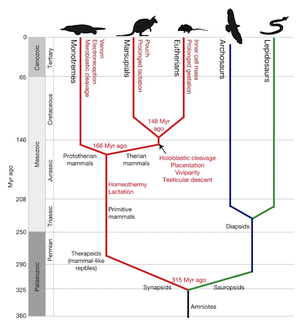Platypus Evolution
Introduction
Select a topic about genetics or evolution in a specific organism or ecosystem.
The topic must include one section about microbes (bacteria, viruses, fungi, or protists). This is easy because all organisms and ecosystems have microbes.
<be>
Platypuses (Ornithorhynchus anatinus) are monotremes, a type of egg-laying mammal with mammary glands and a flat beak. Aboriginal people in different regions have different names for the animal, including mallingong, boondaburra, and tambreet.[1] Platypuses are the only remaining member of the family Ornithorhynchidaeare, and there are only four other species of egg-laying mammals. Clearly, platypuses are unique. They live in the permanent river systems of eastern Australia, Tasmania, King’s Island, and Kangaroo Island, distributed across various environments ranging from tropical to alpine. Despite their range of environments, however, the IUCN deemed them “Near Threatened” in 2016.[2]

At right is a sample image insertion. It works for any image uploaded anywhere to MicrobeWiki. The insertion code consists of:
Double brackets: [[
Filename: PHIL_1181_lores.jpg
Thumbnail status: |thumb|
Pixel size: |300px|
Placement on page: |right|
Legend/credit: Electron micrograph of the Ebola Zaire virus. This was the first photo ever taken of the virus, on 10/13/1976. By Dr. F.A. Murphy, now at U.C. Davis, then at the CDC.
Closed double brackets: ]]
Other examples:
Bold
Italic
Subscript: H2O
Superscript: Fe3+
I don't know
Genetics
Include some current research, with at least one image.
<be>
Fossil Record
The oldest evidence of O. anatinus ancestry is a fragment of a Pliocene platypus, Ornithorhynchus agilis, from roughly 3.8 million years ago. Researchers identified the species Obdurodon insignis based on two teeth in southern Australia that date back to the Oligocene approximately 26 Mya, and more fossils have since been found. Scientists found Obdurodon dicksoni in freshwater limestone from the Middle Miocene, around 15 Mya, and a larger species, Obdurodon tharalkooschild, was also found in the same area.[2]

Double brackets: [[
Filename: Platypus_phylogeny.png
Thumbnail status: |thumb|
Pixel size: |300px|
Placement on page: |right|
Legend/credit: Platypus phylogeny by Warren et al. [4]
Closed double brackets: ]]
For multiple use of the same inline citation or footnote, you can use the named references feature, choosing a name to identify the inline citation, and typing [6]
Second citation of Ref 1: [4]
Microbiome
Include some current research, with a second image.
Conclusion
Overall text length (all text sections) should be at least 1,000 words (before counting references), with at least 2 images.
Include at least 5 references under References section.
References
- ↑ “Evolution & Names.” Australian Platypus Conservancy, 4 Oct. 2021, https://platypus.asn.au/evolution-names/#:~:text=Aboriginal%20people%20had%20many%20different,lonely%20and%20persuasive%20water%2Drat.
- ↑ 2.0 2.1 Zhou, Yang, et al. "Platypus and echidna genomes reveal mammalian biology and evolution." Nature 592.7856 (2021): 756-762.
- ↑ [https://www.flickr.com/photos/striatic/17367 Sudoneighm, Hobvias. Platypus. 30 Mar. 2004.
- ↑ 4.0 4.1 Warren WC, Hillier LW, Marshall Graves JA. "Genome analysis of the platypus reveals unique signatures of evolution" 2008. Nature 453:175–183.
- ↑ Lee G, Low RI, Amsterdam EA, Demaria AN, Huber PW, Mason DT. Hemodynamic effects of morphine and nalbuphine in acute myocardial infarction. Clinical Pharmacology & Therapeutics. 1981 May;29(5):576-81.
- ↑ 6.0 6.1 text of the citation
Edited by Cindy Chen, student of Joan Slonczewski for BIOL 116 Information in Living Systems, 2022, Kenyon College.
